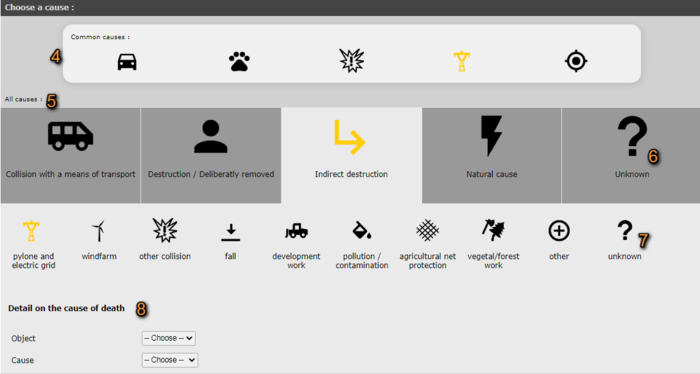Modules
Jump to navigation
Jump to search
Un module est un formulaire additionnel qui devient actif sous certaines circonstances.
Par exemple, si vous introduisez une espèce coloniale qui se reproduit pendant la saison de nidification, le module de la colonie s'activera pour demander plus de détails sur la colonie.
Module de mortalité
Si un animal est donnée comme mort, ce module apparaîtra avant de sauvegarder l'enregistrement. Veuillez compléter les informations demandées.
- 1. Condition: cocher comme il convient mort ou blessé.
- 2. Choisir une cause: choisir la cause la plus probable de mort ou de blessure.
- Find shortcuts to the most used causes in Common causes (number 4 on image above). If you select the cause from this panel, the corresponding All causes panel will open highligting the path in yellow (see example below).
- Lorsque la cause du décès ou de la blessure n'est pas représentée dans Causes communes, sélectionnez Toutes les causes (numéro 5 sur l'image Indiquer la cause de la blessure ou de la mort). Choisissez une approximation de la cause dans ce panneau et une autre plus précise dans le panneau qui s'ouvre en dessous (voir l'image ci-dessous). La cause sélectionnée est surlignée en jaune (voir l'image ci-dessous pour un exemple de destruction volontaire par l'homme, ou la chasse).
- Be as precise as possible, but if are not confident of the cause choose Unknown (number 6 in image below). When you know the general cause of injury or death (for example, due to human voluntary destruction) but not the details, choose the general cause and then unknow (number 7 on image below).
- Depending on the cause, the system will ask for further details (number 8 in image below). If this is the case and you have the information, choose the most accurate item from the expandable menu.
- Collision with a means of transport includes all type of collision between a human mean of transport and the animal.
- Collision with a means of transport includes all type of collision between a human mean of transport and the animal.
- Destruction/Deliberately removed includes all related to fishing, hunting or poaching, poisoning or collecting by humans.
- Destruction/Deliberately removed includes all related to fishing, hunting or poaching, poisoning or collecting by humans.
- Indirect destruction includes all human work or human infrastructure that is not volutarily done or created with the goal of destroying or removing animals, but does indirectly (for example, power lines, wind turbines, forestry activities, algriculture nets, pollution, windows...).
- Indirect destruction includes all human work or human infrastructure that is not volutarily done or created with the goal of destroying or removing animals, but does indirectly (for example, power lines, wind turbines, forestry activities, algriculture nets, pollution, windows...).
- Natural cause includes predation, meteorological events, natural disasters (i.e. volcanic activity), falling from nests, exhaustion, illness, accidental drowning (note if the drowning occurs in a man made structure, i.e. swimming pool, the cause of death or injury will be considered "Indirect destruction").
- Natural cause includes predation, meteorological events, natural disasters (i.e. volcanic activity), falling from nests, exhaustion, illness, accidental drowning (note if the drowning occurs in a man made structure, i.e. swimming pool, the cause of death or injury will be considered "Indirect destruction").
- Unknown indicates the cause of death or injury is ot known.
- Unknown indicates the cause of death or injury is ot known.
- 3. Comment: leave a comment if necessary.
Provide further details by expanding the Event follow-up section at the bottom.
- 1. Open/close section.
- 2. Animal collected Indicate if the dead or injured animal has been collected.
- 3. Recipient Select from the expandable menu which institution has the animal at the moment.
- 4. Radiography Indicate if a radiography has been taken of the dead or injured animal.
- 5. Given answer
- 6. Name of recipient/museum Enter the name of the person or institution that has the animal.
- 7. Collection reference Provide the reference if this animal is now part of a collection.
Click SAVE when done, or PREVIOUS to move to the previous page without saving.


